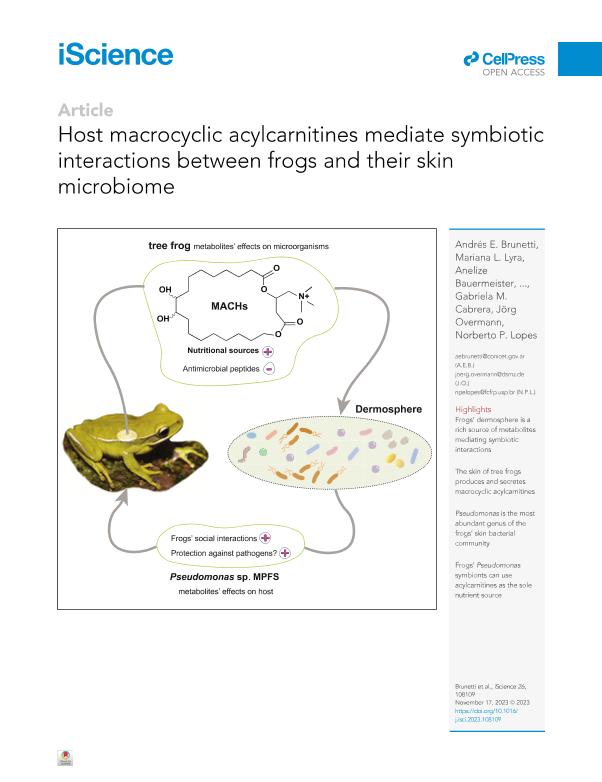Artículo
Host macrocyclic acylcarnitines mediate symbiotic interactions between frogs and their skin microbiome
Brunetti, Andrés Eduardo ; Lucio Lyra, Mariana
; Lucio Lyra, Mariana ; Bauermeister, Anelize; Bunk, Boyke; Boedeker, Christian; Müsken, Mathias; Carnevale Neto, Fausto; Mendonca, Jacqueline Nakau; Caraballo Rodríguez, Andrés Mauricio; Melo, Weilan G. P.; Pupo, Mónica T.; Haddad, Célio F. B.; Cabrera, Gabriela Myriam
; Bauermeister, Anelize; Bunk, Boyke; Boedeker, Christian; Müsken, Mathias; Carnevale Neto, Fausto; Mendonca, Jacqueline Nakau; Caraballo Rodríguez, Andrés Mauricio; Melo, Weilan G. P.; Pupo, Mónica T.; Haddad, Célio F. B.; Cabrera, Gabriela Myriam ; Overmann, Jörg; Peporine Lopes, Norberto
; Overmann, Jörg; Peporine Lopes, Norberto
 ; Lucio Lyra, Mariana
; Lucio Lyra, Mariana ; Bauermeister, Anelize; Bunk, Boyke; Boedeker, Christian; Müsken, Mathias; Carnevale Neto, Fausto; Mendonca, Jacqueline Nakau; Caraballo Rodríguez, Andrés Mauricio; Melo, Weilan G. P.; Pupo, Mónica T.; Haddad, Célio F. B.; Cabrera, Gabriela Myriam
; Bauermeister, Anelize; Bunk, Boyke; Boedeker, Christian; Müsken, Mathias; Carnevale Neto, Fausto; Mendonca, Jacqueline Nakau; Caraballo Rodríguez, Andrés Mauricio; Melo, Weilan G. P.; Pupo, Mónica T.; Haddad, Célio F. B.; Cabrera, Gabriela Myriam ; Overmann, Jörg; Peporine Lopes, Norberto
; Overmann, Jörg; Peporine Lopes, Norberto
Fecha de publicación:
10/2023
Editorial:
Cell Press
Revista:
IScience
ISSN:
2589-0042
Idioma:
Inglés
Tipo de recurso:
Artículo publicado
Clasificación temática:
Resumen
The host-microbiome associations occurring on the skin of vertebrates significantly influence hosts’health. However, the factors mediating their interactions remain largely unknown. Herein, we used integrated technical and ecological frameworks to investigate the skin metabolites sustaining a beneficialsymbiosis between tree frogs and bacteria. We characterize macrocyclic acylcarnitines as the major metabolites secreted by the frogs’ skin and trace their origin to an enzymatic unbalance of carnitine palmitoyltransferases. We found that these compounds colocalize with bacteria on the skin surface and aremostly represented by members of the Pseudomonas community. We showed that Pseudomonas sp.MPFS isolated from frogs’ skin can exploit acylcarnitines as its sole carbon and nitrogen source, andthis metabolic capability is widespread in Pseudomonas. We summarize frogs’ multiple mechanisms to filter environmental bacteria and highlight that acylcarnitines likely evolved for another function but wereco-opted to provide nutritional benefits to the symbionts
Palabras clave:
ACYLCARNITINES
,
FROGS
Archivos asociados
Licencia
Identificadores
Colecciones
Articulos(UMYMFOR)
Articulos de UNID.MICROANAL.Y MET.FISICOS EN QUIM.ORG.(I)
Articulos de UNID.MICROANAL.Y MET.FISICOS EN QUIM.ORG.(I)
Citación
Brunetti, Andrés Eduardo; Lucio Lyra, Mariana; Bauermeister, Anelize; Bunk, Boyke; Boedeker, Christian; et al.; Host macrocyclic acylcarnitines mediate symbiotic interactions between frogs and their skin microbiome; Cell Press; IScience; 26; 11; 10-2023; 1-20
Compartir
Altmétricas



